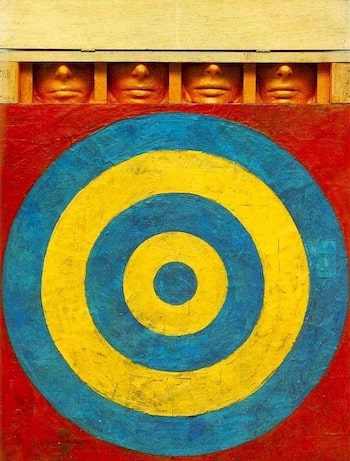Target with Four Faces, 1958 by Jasper Johns

The image of the target emerges in Johns work in 1955, in paintings that incorporate frieze like arrangements of plaster casts taken from parts of the body. Target with Four Faces is one of the serie paintings and drawings of
the target image from 1958 to 1961. Each of these Target paintings by Johns features a depiction of an actual target that is, for all practical purposes, utterly interchangeable with the real thing. Yet unlike the flag or the number,
which are also familiar images from this period of the artist's career, the flat target is simultaneously representational and abstract (a number or a flag can never be divorced from its status as a familiar sign). This makes the
target susceptible to other ambiguities. Targets imply, or are instruments of, seeing across space (and seeing as an act of potential violence). But the optical nature of the concentric bands can also be understood to figure
distraction rather than focus, something that is also suggested by the mechanical action of a rotating compass by which the image of a target is produced.
Johns' targets ideas suggested by the early flags, but more abstractly. An American flag is always the same while a target can be any number of things - all that unites targets is a common format of concentric circles. A flag is bound
to one nations; a target is universal. The colors of the flag are fixed; in the target, they need only be contrasting.
The target also focuses attention on the theme of viewing. the contrasting circles of the target are meant to aid distant vision; the target is something to see clearly, to aim at. This makes the target a true visual display - it has no
other purpose, no other reason for existence.
But in his target paintings, Johns went beyond any simple treatment of targets as a symbol. In Target with Four Faces cut-off plaster casts stand above the target surface. The faces are all from th same woman, cast serially. In
each successive casting, the woman was more relaxed and the mouth more open. Johns originally intended to arrange the casts in the order they were made, but he was obliged to rearrange the casts so that there was no sense of a
progression, of "a mouth about to speak," which he did not want.
